
PLANT TAXONOMY AGRI 223
There are about 415,000 different kinds of land plants in the world. They are essential to our welfare and that of our livestock. Plant taxonomy focusses on describing and naming differing kinds of plant because this makes it possible to share information about them, information that can help us learn more about them. It is this enabling of data sharing that makes understanding plant taxonomy critical in many different fields, including agriculture, medicine, and art.
AGRI 223 provides an introduction to the principles of plant taxonomy and their application to the vascular plants of Somaliland and adjacent regions. It will emphasize hands-on experience in identification, documentation, and environmental adaptations of Somaliland’s plants with some emphasis on those of agricultural significance. It will focus on plants in Somaliland, but the principles covered will be applicable elsewhere, including in other environments, and to other taxonomic groups.
What you will learn?
- The importance of globally recognized names to learning about plants and their properties.
- How plants are classified, with an emphasis on current approaches.
- Major evolutionary adaptations represented by today’s vascular plants.
- How to use existing resources to determine a plant’s current classification and name.
- The characteristics of important plant families and species in your area.
- How to prepare high quality, well-documented specimens.
- The meaning of many words used to describe vascular plants
